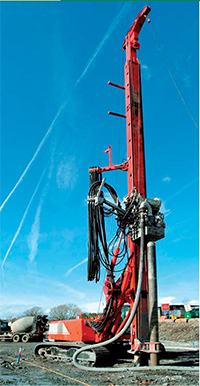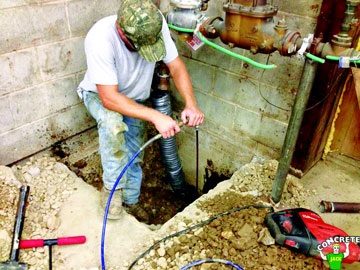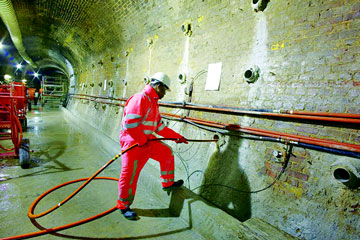Grouting For Ground Improvement
Grouting technology has become a common ground improvement method used frequently for underground and foundation constructions. The process of grouting consists of filling pores or cavities in soil or rock with a liquid form material to decrease the permeability and improve the shear strength by increasing the cohesion when it is set. Cement base grout mixes are commonly used for gravely layers or fissure rock treatment. But the suspension grain size may be too big to penetrate sand or silty-sand layers. In this case, chemical or organic grout mixes are also used. In recent years, the availability of ultrafine grout mixes has extended the performance of hydraulic base grout for soil treatment.
Applications
Grouting has been using in civil engineering for quite a long time. Its traceable record can be as early as in the beginning of 1800s.
- In 1802, the idea of improving the bearing capacity under a sluice by the injection of self-hardening cementitious slurry was first introduced (Henn 1996).
- In 1864, Peter Barlow patented a cylindrical one-piece tunnel shield which could fill the annular void left by the tail of the shield with grout.
- And it is the first recorded use cementitious grout in underground construction (Henn 1996).
- In 1893, the first systematic grouting of rock in the USA as performed at the New Croton Dam, in New York (Henn 1996).
- In 1960s, jet grouting technique was developed (Henn 1996).
- In 1977, first application of compaction grouting for controlling ground movement during construction of the Bolton Hill Tunnel (Henn 1996).
- In 1995, the first industrial application of the compensation grouting concept was conducted at the construction site of the Jubilee Line Extension Project in London (Gilles Buchet et al 1999).
Initially, its application confines mainly in void filling, water stopping and consolidation. Nowadays, it extends to alleviate settlement of ground caused by basement and tunnel excavation works, to strengthen ground so that it can be used as a structural member or
 |
retaining structure in solving geotechnical problems. Grouting, instead of an old and obsolete ground treatment technique, it is still developing in both methodology as well as hardware engineering. And its application is extending in the civil engineering field, from small-scale remedial work site to very large-scale project site. It is still the most popular ground treatment method used today.
The advantages of grouting include:
- Can be performed on almost any ground condition
- It doesn't induce vibration and can be controlled to avoid structural damages
- Improvements to ground formations can be measured
- Very useful for confined spaces and low headroom applications
- Used for slab jacking to lift or level distorted foundations
- Can be installed adjacent to existing walls
- Can be used to control seepage, groundwater flows and hazardous waste plumes
|
Types of Grouting
Compaction grouting
Compaction grouting is a ground treatment technique that involves injection of a thick-consistency soil cement grout under pressure into the soil mass, consolidating, and thereby densifying surrounding soils in place. The injected grout mass occupies void space created by pressure-densification. Pump pressure, as transmitted through low-mobility grout, produces compaction by displacing soil at depth until resisted by the weight of overlying soils.
When injected into very dense soils or bedrock, compaction grout remains somewhat confined, since the surrounding material is quite dense. However, when injected into under-consolidated or poorly compacted soils, grout is able to "push" these materials aside.
When grouting treatment is applied on a grid pattern, the result is improved compaction of displaced soils and greater uniformity of the treated soil mass. As a secondary benefit, the resulting grout columns add strength in the vertical axis, as typical grout compressive strengths exceed those of the surrounding soils. Compaction grouting applications include densification of foundation soils, raising and relieving of structures and foundation elements, mitigation of liquefaction potential, augmentation of pile capacity and pile repair, and densification of utility trench backfill soils.
 |
Although densification of foundation soils subject to long-term settlement remains to be the principal application, ground improvement methods incorporating compaction grouting methods have become increasingly accepted by the engineering community as a means of mitigating liquefiable soils influencing existing facilities. Inherent in the grouting process is the capacity to work in areas of limited access and existing improvements to treat discrete zones within the soil profile.
Permeation grouting
Permeation grouting is a term used to describe a ground treatment method in which grout is injected into a porous medium without disturbing its original structure. In geotechnical engineering, this usually refers to the process of filling the pores and joints in a soil and/or rock deposit to change its geotechnical properties. Almost any grout material may used for permeation grouting, but there are distinct limits on the grout mix used for specific types of soil or rock. Applications are for enhanced foundation bearing value, improvement of excavation character in sands and reduction of liquefaction potential.
 |
The process is quiet flexible and it can be designed with a minimal disruption at the surface and therefore, it is advantageous for use in urban areas or areas with limited access. During grouting process, injection pressures are usually limited to prevent fracturing or volume change in the natural soil/rock formation. Based on the field trials and the soil conditions, the injection pressures and the grout volumes will be justified to meet the intended performance. Particulate grouts (e.g. cement or bentonite) are generally used for medium to coarse grained sands, such that the particles in the grout easily percolate through the formation. Micro fine cement is also used for fine grained sands where Ordinary Portland Cement cannot percolate through the formation. Chemical grouts (e.g. silicates) are used in formations with smaller pore spaces, but are limited to soils coarser than fine grained sands.
Quality Control & Quality Assurance Like any other grouting improvement process, the quality control during permeation grouting is very important to ascertain the effectiveness of the technique. As such, the process parameters such as grout pressure, flow rate, volume of grout for corresponding depth are monitored throughout the construction process. Post construction in-situ permeability tests are conducted after sufficient curing period to validate the effectiveness of permeation grouting.
Jet Grouting
Applications of the jet grouting system fall into three broad categories: underpinning or excavation support, stabilization of soft or liquefiable soils, groundwater or pollution control. The method consists of soil injection of a mixed fluid at high pressure forming jets that erode and replace the existing soil with the injection mixture. In general this method begins by drilling small-diameter holes (90-150 mm) up to the final injection depth. Cement mixture is injected into the soil with a metal rod that runs a rotational and withdrawal motion whilst. This technology is useful to underpinnings of existing foundations, to support excavations in cohesive less soils, to control the groundwater migration and to improve the strength of liquefiable soil.
The jet grouting technique is developed in the 1960s. However, because of its unique properties, it is becoming quite popular in the civil engineering works. Its main applications are: -
- Grouting of clay / silt soils which is not suitable for TAM grouting technique.
- Jet grout wall and roof are used to reinforce tunnel portal excavation works.
- Sealing of windows of coffer dams
- Used as jet grout raft to reinforce cofferdam to limit its deflection and thus decrease the settlement caused by the excavation works.
Injection Method
Grouting is the process in which grout in liquid form is pumped or jetted into the ground and then hardens. Grouting is also known as Injection in some literatures. Up through the history there has not been much development on the basic injection method. The process of pumping grout under pressure into the ground is still the same until the invention of the jet grouting technique.
Different grout injection methods have been developed for different grouting techniques. In conclusion, there are four main injection methods to inject grout into the ground.
Drill Hole Method
A hole is drilled through the pores/voids of the ground. Then grout is pumped via the grouting line into the surrounding ground of a section with the use of single or double packers.
Drill Tool Method
It is a one-stage grouting method by means of the drill casings or rods. There are two injection methods.
Grout Pipe Method
Grout pipes are installed in drilled hole for later on gout injection operation. The gaps between the grout pipe and the drilled hole are normally sealed. When compared with above Drill Tool Method, it is more flexible as the drilling plant is not engaged in the grouting operation.
For multiple-stage grouting, the sealed-in sleeve pipe injection method (the tube-à-manchettes method) is used. It allows several successive injections in the same zone. The method is to place a grout pipe with rubber sleeves into a grout hole, which is kept open by casing or by mud. This pipe is then permanently sealed in with a sleeve grout composed of a bentonite-cement grout.
Jetting Method
Finally, a different type of injection method, the jet grouting method, is introduced in the 60s, which has a revolutionary change to the grouting concept so far. The grout, with the aid of high pressure cutting jets of water or cement grout having a nozzle exit velocity >= 100m /sec and with air-shrouded cut the soil around the predrilled hole. The cut soil is rearranged and mixed with the cement grout. The soil cement mix is partly flushed out to the top of the predrilled hole through the annular space between the jet grouting rods and the whole wall.
Non-shrink grouting
Non-shrink grouts and mortars shall include, but not necessarily be limited to, pre-packaged, non-shrink, cement-based grouts and mortars requiring only the addition of water. The grouts and mortars shall be specifically formulated for use as a sealant around wall penetrations, for use under machine or column bases, for bolt anchorages, and similar applications where drying shrinkage would be detrimental.
Non-shrink grouts and mortars shall include, but not necessarily be limited to, pre-packaged, non-shrink, cement-based grouts and mortars requiring only the addition of water.
Grout Curtains
Grout curtains are constructed by injecting particulate or chemical grouts under pressure. The types of grout most commonly used are particulate grouts such as Portland cement. Grout curtains reduce the permeability and increase the mechanical strength of the soils but can be three times more expensive than slurry walls. Because of the expense, grouting is best suited to seal unsound rock and for situations where other barrier walls are impractical. In addition to cost considerations some chemical grouts such as phenolic, acrylamide and polyester are not often used or are not available because their toxicity requires special care in handling and for safeguards after implementation.
Grouting Technique
The injection of grout into the rock mass joint systems can be performed by applying different methods. The key to success is to choose the right method for the particular situation. The correlation between the needed grouting effort and a sealing result, which fulfils the inflow requirement, is often difficult to determine, but may be possible using methods developed during the latest years.
Some principles for grouting
When the joint systems of the rock mass have been identified, the grouting should be adopted for the particular situation. The rock mass normally consists of different types of joint systems. To reach a satisfactory level of sealing it is often necessary to outline at least two different main joint systems which need different kinds of treatment, regarding grout proportion, grout pressure and whole setting. Therefore, for example Palmqvist (1983) recommended that grouting is performed in two stages. During the first stage the sealing is concentrated on course sealing and during the second stage the sealing is concentrated on fine sealing.
Grouting method increases shear strength of weak soil and therefore reduces the risk of liquefaction. This method of stabilization is best worked for loose sandy soil.
The geometry of the joint system could be generalised by two events, the horizontal open joints and the vertical open joints.
Volume, flow, pressure, GIN and INJ-criteria
Different grout criteria are set up to limit the amount of grout in the rock mass. The maximum volume is usually restricted because excess volume can damage surrounding constructions or lift the rock mass. The maximum allowed pressure is generally set in relation to the water pressure and the rock overburden, which should not be lifted. Depending on the grout mix, the rock mass could be lifted or even fractured after a very short time of high pressure. The maximum grout volume considers the risk of long penetration lengths which may affect the uplift as well as the filling of unwanted areas.
Grout order
The grout order can be important for the sealing result. An erroneous grouting order can result in blocking of flow paths that needs to be open until other flow path have been fully reached. A correct handling of grout order and flow path for a satisfactory penetration and filling of the joint system is a complex and difficult job.
Two phases of Grouting Technique
This grouting technique has two phases, namely the cement bentonite grouting phase and the chemical grouting phase. Hence, the grouting mechanism of this technique is best described with two phases. In the cement bentonite grouting phase, the grout fills up the relict joints of the soil mass and the large voids between the soil particles. In the chemical grouting phase, the chemical grout, which is a chemical solution penetrates and fills up the voids between the soils particles. All the infilling ground water is expelled. When the grout has set, the soil mass becomes a matrix of soil and grout and possess properties quite different from its original soil mass.
Conclusion
Grouting method increases shear strength of weak soil and therefore reduces the risk of liquefaction. This method of stabilization is best worked for loose sandy soil. Each of those techniques is applied in different situations for the same purpose. Compacting grouting is successfully applied to densify a thick loose sand layer in urban environment. This method densifies loose sandy soil and mitigates liquefaction of soil by injection in the soil without entering in its pores. Permeation grouting is very effective in increasing the resistance of uncompacted soils against liquefaction by injection in the soil pores without changing its physical structure. Jet grouting is suitable method to underpinning of existing foundation to improve the strength of liquefiable soil but it neither stiffen the ground nor reduce shear stresses of soil. Jet columns provide bearing support and reduce settlement if liquefaction is limited to a specific zone.
References: